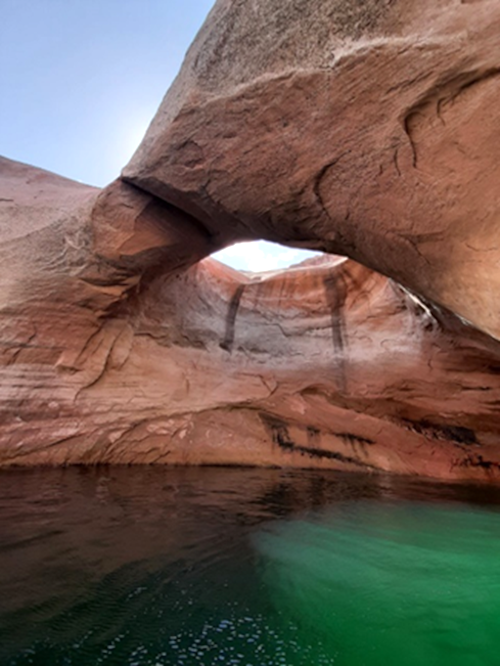
The arch before it collapsed/NPS file
A well-known arch at Glen Canyon National Recreation Area along Lake Powell, nicknamed "Toilet Bowl" as well as "Hole in the Roof" and other names, has collapsed.
Rangers say the arch, located in Rock Creek Bay, collapsed on Thursday, although a park release did associate a cause. The “Double Arch” geologic feature was also referred to as “Crescent Pool.”
No injuries were reported to have resulted from the collapse.
Double Arch was formed from 190-million-year-old Navajo sandstone originating in the late Triassic to early Jurassic periods, park staff said.
Since formation, this fine-grained sand feature has been subject to spalling and erosion from weather, wind, and rain. Changing water levels and erosion from wave action is suspected of contributing to the ultimate collapse of the arch.

After the arch collapsed/NPS August 9, 2024
"This event serves as a reminder of our responsibility and need to protect the mineral resources surrounding Lake Powell. These features have a life span that can be influenced or damaged by manmade interventions," said Glen Canyon Superintendent Michelle Kerns. "While we don’t know what caused this collapse, we will continue to maintain our resource protection efforts on Lake Powell for future generations to enjoy. Please enjoy our resources but leave no trace.”









Comments
Don't be an idiot. It's being blamed on Lake Powell which is certainly a change in the supporting rock in the last several decades. Not global warming.
There's no way of knowing what happened here, which the Superintendent makes clear. I would suspect that this was not an arch that a lot of people could climb on or under. However, it might help to understand that Lake Powell is hardly a natural lake, where the flow of water affects the sandstone.
I've visited other arches before, and often one can see what's clearly human-caused erosion around the base. Not sure what can be done about that other than declaring no-go areas. There's another place called Double Arch in Arches National Park, which is a very popular place for people to scramble under the arch. And I've clearly seen sandstone erosion all over NPS areas, which is inevitable when there's visitation.
Obviously natural changes would have an impact.
Surely the most logical way to present this story would be with a BEFORE and AFTER shot, wouldn't it?... What might have been interesting additional relevant information would have been a report on wear and tear from tourists, total annual number of visitors....people climbing all over the arch for photo ops etc and so on
Climate change? Seriously? Not everything that goes wrong in the world can be blamed in climate change.j5rQ
Correct me if I'm wrong, but Lake Powell is man-made, right? So submerging much of an arch underwater when it didn't form that way seems like a man-made cause. Either way, no biggie, nature will just make more.
Of course, all these formations were formed by erosion, and all are currently being slowly destroyed by erosion. Duh.
One has to wonder, if the dam was never built to form this lake, would this natural wonder still exist today? Its dimise was sure to happen at somepoint, but did "we" hasten it in any way?